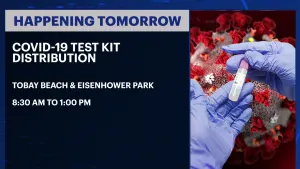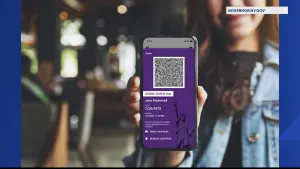More Stories

You or a family member are sick and need to see a doctor, but are under stay-at-home orders. A virtual doctor visit can help!
Amid the COVID-19 outbreak, many health providers are now offering telehealth as a way of keeping people home to help stop the spread of the virus.
Telehealth allows for long-distance patient and doctor contact. Doctors can provide care, advice and monitor your symptoms.
Many providers are also evaluating patients for COVID-19 through virtual visits.
Here are six things to know before scheduling a virtual doctor visit.
What do you need?
You will need a computer, tablet or smartphone that have a camera and microphone. Some providers also have mobile applications, but most virtual visits can be done through a browser.
You will need a computer, tablet or smartphone that have a camera and microphone. Some providers also have mobile applications, but most virtual visits can be done through a browser.
Who can be seen?
Most adults and children. For example, Northwell GoHealth Urgent Care sees children over 1 year, while NYU Langone sees children age 5 and older.
Most adults and children. For example, Northwell GoHealth Urgent Care sees children over 1 year, while NYU Langone sees children age 5 and older.
What type of conditions can be treated during a virtual visit?
It depends on the provider. Here's a list of some conditions that Northwell GoHealth Urgent Care and NYU Langone cover.
It depends on the provider. Here's a list of some conditions that Northwell GoHealth Urgent Care and NYU Langone cover.
Northwell GoHealth Urgent Care:
Allergies, asthma attacks, wheezing, animal or insect bites (minor), bronchitis, respiratory infection, colds, cough, flu, mild fever, earache, ear infection, headache, migraine, pink eye, eye infection, poison oak, poison ivy, rash, skin infection, sinus infections, sore throat, laryngitis, strep, sprains. strains, and urinary tract infection (UTIs).
Allergies, asthma attacks, wheezing, animal or insect bites (minor), bronchitis, respiratory infection, colds, cough, flu, mild fever, earache, ear infection, headache, migraine, pink eye, eye infection, poison oak, poison ivy, rash, skin infection, sinus infections, sore throat, laryngitis, strep, sprains. strains, and urinary tract infection (UTIs).
NYU Langone:
Cough, pink eye, sinus pain, urinary tract infection or urinary frequency, abdominal pain (minor), abdominal pain (minor), allergy, back pain (minor), cold sores, cuts and bruises (minor), diarrhea, fevers (mild), gout, head injury (minor), headache (mild), heartburn, lymph node swelling, motion sickness, mouth sores, rashes, runny nose (rhinorrhea), sore throat, sprains or strains, upper respiratory illness (mild), viruses, and vomiting.
Cough, pink eye, sinus pain, urinary tract infection or urinary frequency, abdominal pain (minor), abdominal pain (minor), allergy, back pain (minor), cold sores, cuts and bruises (minor), diarrhea, fevers (mild), gout, head injury (minor), headache (mild), heartburn, lymph node swelling, motion sickness, mouth sores, rashes, runny nose (rhinorrhea), sore throat, sprains or strains, upper respiratory illness (mild), viruses, and vomiting.
How much does it cost?
Depends on the provider, and your insurance. Call your insurance and ask about telehealth, and what providers are in your network. Some providers will also offer appointments even if you don't have insurance.
Depends on the provider, and your insurance. Call your insurance and ask about telehealth, and what providers are in your network. Some providers will also offer appointments even if you don't have insurance.
How does a virtual visit work?
Just like a video call, a virtual visit lets you meet with a health care provider via video, from the comfort of your home. In most cases, you'll have to visit the health provider's website to make an appointment, but some doctors' offices require that you call to make the appointment.
Just like a video call, a virtual visit lets you meet with a health care provider via video, from the comfort of your home. In most cases, you'll have to visit the health provider's website to make an appointment, but some doctors' offices require that you call to make the appointment.
About 15 minutes before the appointment, you will receive an email, text message and/or app notification with a link to your video session. Click the link to enter your personal information, sign consent forms and pay for your visit or insurance co-pay.
When you connect to the video session, your provider will be notified and will join the call.
Will a provider prescribe medicine via video?
If the doctor deems it necessary, yes. Prescriptions will be handled just like an in-person visit, and will be electronically submitted to your pharmacy. However, some providers might not prescribe certain medicines, like narcotics. If your pharmacy has an option to get alerts when the medicine is ready, opt for them, that way you can lower your exposure to the virus at the pharmacy. Some pharmacies are also offering prescription deliveries.
If the doctor deems it necessary, yes. Prescriptions will be handled just like an in-person visit, and will be electronically submitted to your pharmacy. However, some providers might not prescribe certain medicines, like narcotics. If your pharmacy has an option to get alerts when the medicine is ready, opt for them, that way you can lower your exposure to the virus at the pharmacy. Some pharmacies are also offering prescription deliveries.
More from News 12
0:26

At-home COVID-19 test kits to be distributed at 2 Nassau locations this weekend
0:23

New Excelsior Pass Plus app extends beyond New York jurisdiction

Your Coronavirus 2020 Photos

10 online learning tools for students to use at home
11:21:40

6 tips for home schooling children and remote learning
